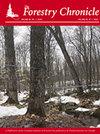林业对树木改良的投资——明智的商业决策还是无底洞?加拿大阿尔伯塔省一个新的树木改良评估模型的答案
IF 1.2
4区 农林科学
Q3 FORESTRY
引用次数: 10
摘要
阿尔伯塔省对树木改良(TI)的持续投资目前正处于十字路口,尽管TI在全球范围内都有明显的好处。根据私营企业的说法,进一步投资的主要障碍是目前省政府设定的年度允许削减(AAC)中确认的最低遗传增益。为了更好地了解TI项目盈利能力的关键参数,我们开发了“阿尔伯塔省林业树木改良投资”估值模型(TIIFA)。除了年贴现率的巨大影响外,使用TIIFA模型的敏感性分析表明,不仅遗传增益,而且改良种子的部署区域都是影响TI项目盈利能力的关键参数。此外,研究结果表明,TI项目的收益在很大程度上超过了相关项目的成本,无论其设定为每十年1万美元、3万美元还是500万美元。我们得出的结论是,尽管目前已经认识到遗传增益的水平。。。本文章由计算机程序翻译,如有差异,请以英文原文为准。
Forest industry investment in tree improvement – a wise business decision or a bottomless pit? Answers from a new tree improvement valuation model for Alberta, Canada
Continued investment in tree improvement (TI) in Alberta is currently at a crossroads despite the demonstrated benefits of TI worldwide. According to private industry, the major roadblock for further investment is the minimal amount of genetic gain currently recognized in the annual allowable cut (AAC) set by the provincial government. In order to better understand the key parameters that drive profitability in TI programs, we developed the “Tree Improvement Investment for Forestry in Alberta” valuation model (TIIFA). Besides the large effect of the annual discount rate, sensitivity analyses using the TIIFA model revealed that not only genetic gain, but also the area on which improved seed is deployed represent key parameters influencing the profitability of TI programs. Furthermore, results show that the benefits of TI programs largely outweigh associated program costs, whether they were set at $1, $3 or $5 million dollars per decade. We conclude that despite the current levels of genetic gain recognized...
求助全文
通过发布文献求助,成功后即可免费获取论文全文。
去求助
来源期刊

Forestry Chronicle
农林科学-林学
CiteScore
1.20
自引率
0.00%
发文量
6
审稿时长
18-36 weeks
期刊介绍:
The Canadian Institute of Forestry has published The Forestry Chronicle, a professional and scientific forestry journal, since 1925. The Forestry Chronicle is published to provide information to forest practitioners about professional and scientific management of forests and their resources. The Forestry Chronicle provides forest practitioners in Canada and around the world with a means to communicate with their peers in the professional community.
 求助内容:
求助内容: 应助结果提醒方式:
应助结果提醒方式:


